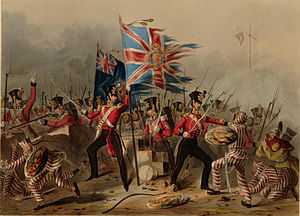Battle of Amoy
| Battle of Amoy | |||||||
|---|---|---|---|---|---|---|---|
| Part of First Opium War | |||||||
 The 18th (Royal Irish) Regiment of Foot storming the Amoy forts | |||||||
| |||||||
| Belligerents | |||||||
| Qing Dynasty | |||||||
| Commanders and leaders | |||||||
|
Hugh Gough, William Parker | |||||||
| Strength | |||||||
|
15 ships,[1] 2,500 troops[2] | 5,600–10,000 troops[3] | ||||||
| Casualties and losses | |||||||
|
2 killed,[4] 15 wounded[5] |
Heavy casualties,[6] 500 pieces of ordnance captured[7] | ||||||
The Battle of Amoy was fought between British and Chinese forces in Amoy (Xiamen), China, on 26 August 1841, during the First Opium War. The British captured the forts in Amoy and Gulangyu Island.
Battle
Prior to the engagement Qing Dynasty forces prepared defenses along the shores of Amoy and built batteries on Gulangyu Island. The British began the battle by bombarding the island's batteries for two to four hours (sources vary), with little effect. Land forces then disembarked their transports and took the batteries with little resistance. The day was noted as being very hot and fatiguing to the men. Qing forces withdrew and the city fell the next day. A garrison force of 550 men, mostly from the 18th and three ships – the Druid, Pylades, and the Algerine – was left moored at Gulangyu to defend Amoy.[8]
Rosa Luxemburg provides a brief account of the battle in her magnum opus The Accumulation of Capital.
- "On August 25, 1841, the British approached the town of Amoy, whose forts were armed with a hundred of the heaviest Chinese guns. These guns being almost useless, and the commanders lacking in resource, the capture of the harbour was child’s play. Under cover of a heavy barrage, British ships drew near the walls of Kulangau, landed their marines, and after a short stand the Chinese troops were driven out. The twenty-six battle-junks with 128 guns in the harbour were also captured, their crews having fled. One battery, manned by Tartars, heroically held out against the combined fire of three British ships, but a British landing was effected in their rear and the post wiped out." (Luxemburg, Rosa (1913) The Accumulation of Capital Routledge, 2013 p371)
Commander John Elliot Bingham (late first lieutenant of HMS Modeste) wrote a detailed first hand account of the battle from a British perspective.
British order of battle
| Officers | Enlisted men | |
|---|---|---|
| Artillery | 9 | 240 |
| 18th | 30 | 648 |
| 26th | 8 | 153 |
| 49th | 24 | 460 |
| 55th | 26 | 731 |
| Madras Sappers | 6 | 184 |
| total | 103 | 2416 |
Ships: Wellesley, 74 ; Blenheim, 74 ; Blonde, 4:4 Druid, 44; Modeste, 18; Cruiser, 18; Pylades, 18; Columhine, 16 Bintinch, 10 ; Algerine, 10 ; Sesostris, 4 ; Phlegethon, 4 ; Nemesis, 4 Queen, 4[9]
Gallery
-

Storming of Amoy by the British fleet
-

Taking of Amoy
-

Capture of Amoy, plate 1
-

Plate 2
-

Plate 3
-

View of the capture of Amoy (colour version of Capture of Amoy, plate 1)
Notes
- ↑ MacPherson 1843, p. 350
- ↑ Hall & Bernard 1846, p. 230
- ↑ MacPherson 1843, p. 342
- ↑ MacPherson 1843, p. 347
- ↑ MacPherson 1843, pp. 338, 347
- ↑ MacPherson 1843, p. 336
- ↑ MacPherson 1843, p. 338
- ↑ Frontier and Overseas Expeditions From India, Vol IV Expeditions Overseas. Calcutta: Superintendent Government Printing.(1911)
- ↑ Frontier and Overseas Expeditions From India,(382)
References
- Hall, William Hutcheon; Bernard, William Dallas (1846). The Nemesis in China (3rd ed.). Henry Colburn.
- MacPherson, Duncan (1843). Two Years in China (2nd ed.). Saunders and Otley.
- Frontier and Overseas Expeditions From India, Vol IV Expeditions Overseas. Calcutta: Superintendent Government Printing,1911.(382)
- Luxemburg, Rosa (1913) The Accumulation of Capital [Reprinted Routledge, 2013]
- Bingham, John Elliot (1843) Narrative of the Expedition to China from the Commencement of the War to Its Termination in 1842: With Sketches of the Manners and Customs of that Singular and Hitherto Almost Unknown Country, Volume 2 H. Colburn
Coordinates: 24°26′51″N 118°03′45″E / 24.447618°N 118.062451°E